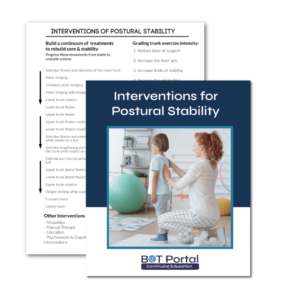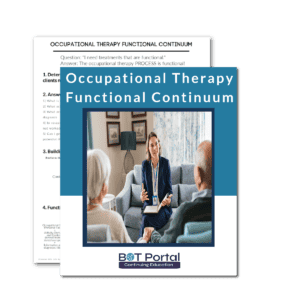Description
Increase Stability: Tips for Mobility
Note: These ideas to increase stability are only to inform daily practice. Many research-supported intervention trajectories are shown to promote remediation, and everyone is different! Do your research! This is merely a tool in your toolkit. 🙂
Improving stability is a critical aspect of rehabilitation and therapy, particularly for individuals recovering from injuries, surgeries, or conditions that affect mobility and balance. Unlike balance, which refers to the ability to maintain an upright position or stay steady while standing or moving, stability encompasses the body’s ability to resist external forces and maintain control over its center of gravity. For therapists, addressing stability is essential as it helps enhance overall functional independence, reduce the risk of falls, and improve quality of life for their clients.
- Enhanced Functional Independence: Stability is crucial for performing daily activities such as walking, standing, and transferring safely. By improving stability, therapists can help individuals regain confidence and autonomy in their movements, allowing them to participate more fully in activities of daily living and maintain independence.
- Fall Prevention: Instability and loss of balance are significant contributors to falls, which can result in serious injuries, hospitalizations, and reduced mobility. By addressing stability issues, therapists can help reduce the risk of falls and minimize the likelihood of fall-related injuries, promoting safety and well-being for their clients.
- Optimized Movement Patterns: Stability training can help individuals develop more efficient movement patterns and neuromuscular control, leading to smoother and more coordinated movements. This can be especially beneficial for athletes, dancers, and individuals engaged in physical or occupational activities that require precise control and coordination.
- Reduced Risk of Secondary Injuries: Instability and poor balance can increase the risk of secondary injuries, such as sprains, strains, and fractures, particularly in individuals with musculoskeletal conditions or neurological impairments. By addressing stability deficits, therapists can help reduce the risk of these secondary injuries and promote faster recovery and rehabilitation.
- Improved Confidence and Quality of Life: Instability and fear of falling can significantly impact an individual’s confidence, mobility, and overall quality of life. By addressing stability issues and providing targeted interventions, therapists can help boost their clients’ confidence, enhance their sense of security and well-being, and promote a more active and fulfilling lifestyle.
This handout provides practical tips to support stability, including exercises, strategies, and recommendations to help individuals improve their stability, reduce the risk of falls, and enhance overall functional independence. By incorporating these tips into their daily routines, individuals can take proactive steps to enhance stability, improve mobility, and maintain optimal physical function and well-being. Therapists play a crucial role in guiding and supporting individuals in their stability training journey, empowering them to achieve their rehabilitation goals and live life to the fullest.
Other helpful links:
Check out BOT Portal: Resource Site for Occupational Therapy Students and Practitioners




